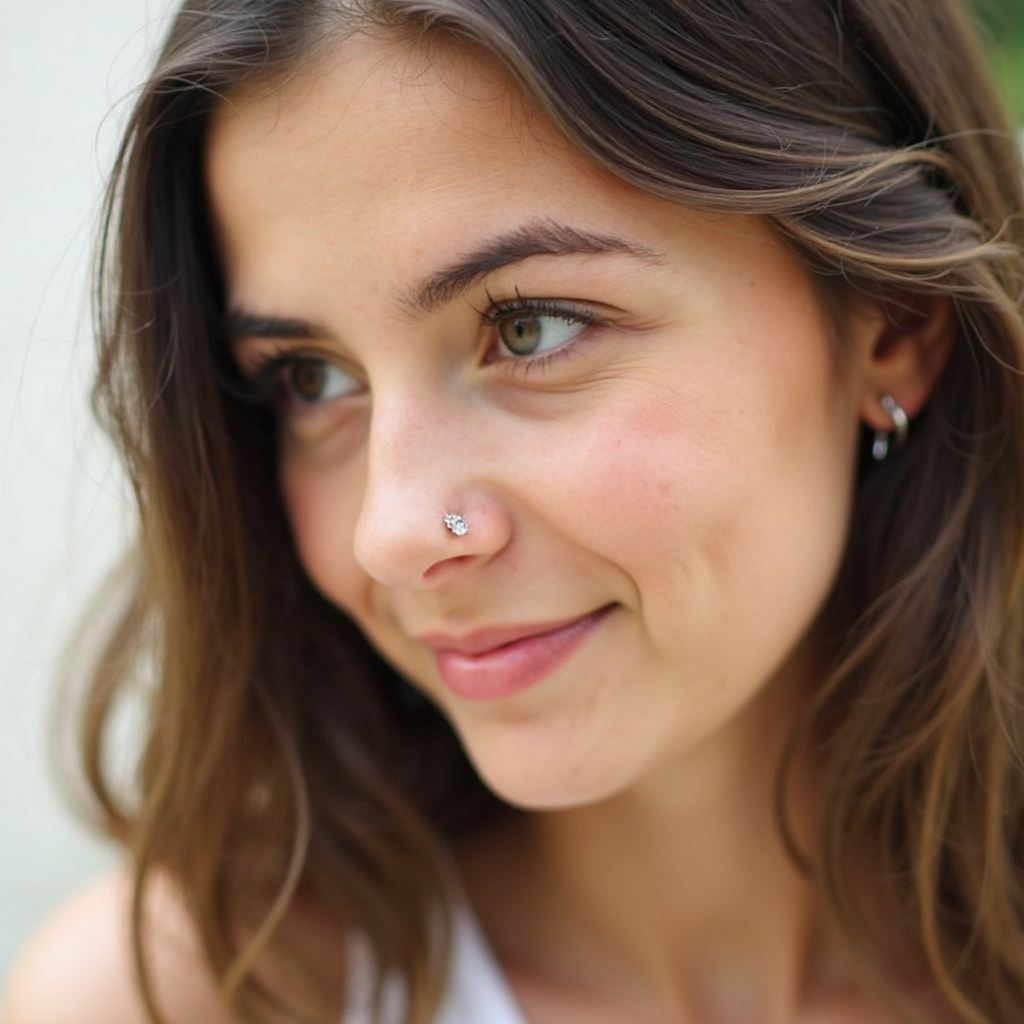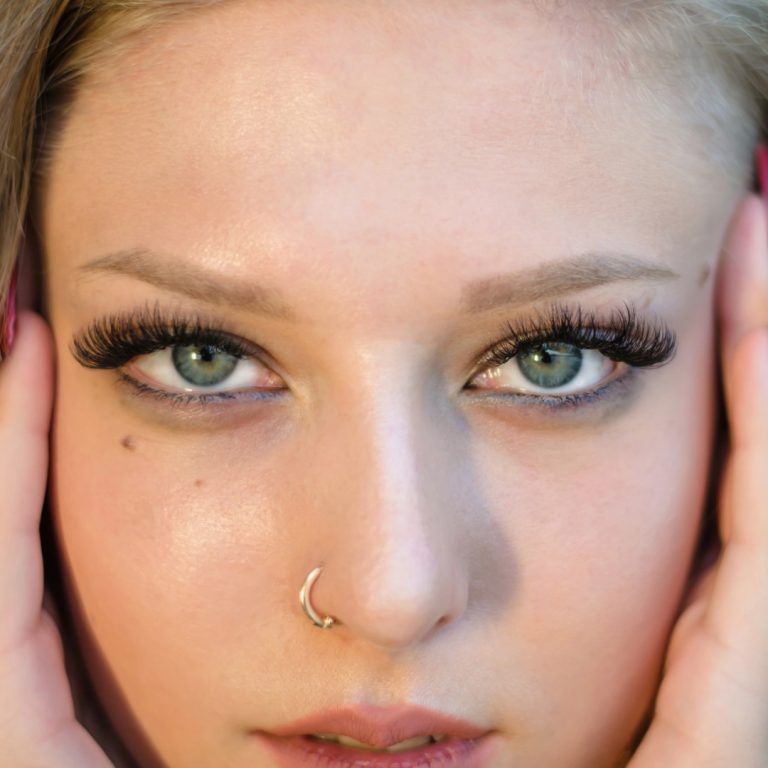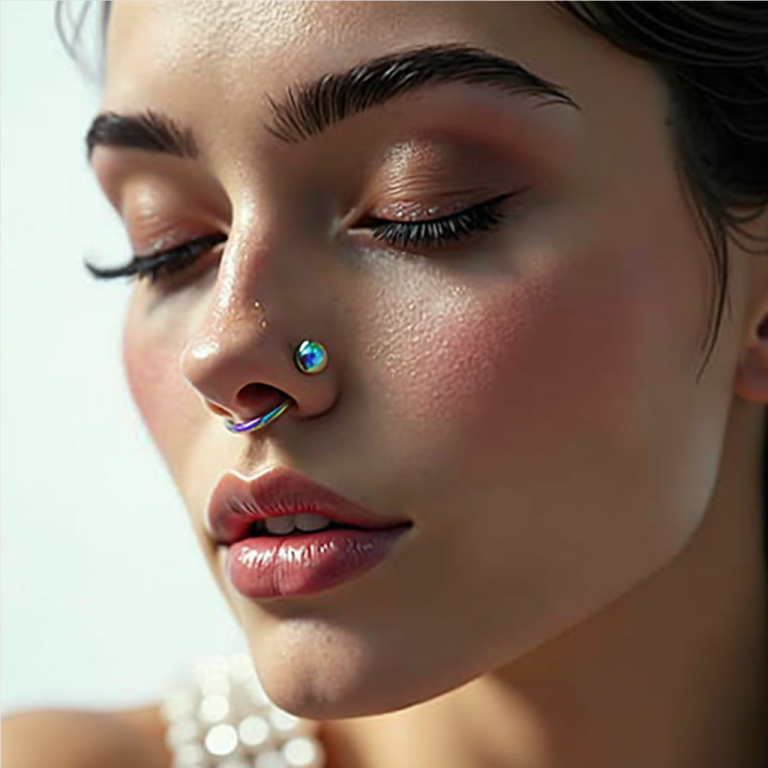Nose piercings continue to evolve as one of the most popular forms of self-expression, with 2026 bringing fresh twists on classic styles alongside completely new placement options. The biggest trends for 2026 include constellation-style nostril arrangements, oversized septum rings, and eco-friendly jewellery materials like recycled titanium and surgical steel.

Current data shows that nose piercing trends are experiencing a major moment, with search interest for nose rings peaking during summer months and steady growth in demand for both minimalist and bold statement pieces. The influence of social media and celebrity culture has pushed nostalgic ’90s and Y2K revival styles back into the spotlight, whilst sustainability concerns are driving innovation in piercing materials.
Whether someone is considering their first nose piercing or looking to add to an existing collection, 2026 offers exciting options that balance personal style with practical considerations. From understanding the most flattering placements for different face shapes to choosing the right materials for healing and long-term wear, this comprehensive guide covers everything needed to navigate the latest nose piercing landscape.
Overview of Nose Piercing Trends in 2026

The nose piercing landscape in 2026 emphasises simplicity with delicate studs gaining popularity, whilst bold layering techniques create striking facial compositions. Material innovation focuses on sustainable titanium and eco-friendly gold alternatives that prioritise skin health.
Rise of Minimalistic Studs
Minimalistic nose piercings dominate 2026 with subtle studs reflecting culture and fashion. Small gemstone studs and seamless designs appeal to professionals seeking understated elegance.
Popular minimalistic styles include:
- Flat-back titanium studs (1.5-2mm)
- Single crystal points
- Threadless push-fit designs
- Ultra-thin nose bones
The trend towards dainty hoops and seamless rings reflects a shift toward subtle sophistication. These pieces work well in conservative environments whilst maintaining personal expression.
Placement precision matters more than size. Many choose higher nostril positions or off-centre placements to create unique looks without overwhelming facial features.
Bold Statement Pieces and Layering
Statement nose piercings embrace gemstone-embellished and stacked combinations like septum plus nostril arrangements. Multiple piercings create personalised constellations across the nose area.
Common layering combinations:
- Double nostril with connecting chain
- Septum clicker with nostril stud
- Bridge piercing with traditional nostril
- Triple nostril arrangements
Large ornate septum pieces featuring intricate metalwork gain traction. These designs often incorporate cultural motifs or nature-inspired patterns.
Asymmetrical placements challenge traditional piercing positions. Some opt for high nostril piercings paired with standard placement for dynamic visual interest.
Sustainable and Hypoallergenic Materials
Hypoallergenic materials and eco-conscious options drive material choices in 2026. ASTM F-136 titanium and 14-karat gold dominate the premium market.
Preferred materials include:
| Material | Benefits | Price Range |
|---|---|---|
| Titanium | Hypoallergenic, lightweight | £15-£80 |
| 14k Gold | Biocompatible, durable | £40-£200 |
| Niobium | Colour options, safe | £20-£60 |
Recycled metals appeal to environmentally conscious consumers. Many manufacturers now offer jewellery made from reclaimed gold and ethically sourced gemstones.
Surgical steel remains popular for initial piercings due to affordability. However, titanium and gold priorities for safety make them preferred long-term options.
Popular Nose Piercing Styles and Placements

Nose piercing placement options have expanded significantly beyond traditional nostril studs. Modern techniques now include elevated nostril positions, central septum placements, and bold bridge configurations that create striking facial symmetry.
Nostril Piercing Evolution
The classic nostril piercing has transformed from simple side-of-nose placement to multiple sophisticated variations. Traditional nostril piercings sit in the crease where the nostril curves, but contemporary styles explore different angles and heights.
Modern placement options include:
- Standard nostril (lower curve)
- Mid-nostril positioning
- Double nostril piercings on one side
- Bilateral nostril arrangements
The nostril piercing remains the second most popular piercing type after ear piercings. Many clients now request multiple nostril piercings to create constellation patterns around the nose area.
Jewellery choices have expanded beyond basic studs. Flat-back labret studs provide comfort for daily wear. Threadless ends allow easy jewellery changes without removing the entire piece.
Healing considerations: Standard nostril piercings typically heal within 2-4 months. Proper aftercare prevents complications and ensures optimal placement results.
Septum Piercing Resurgence
Septum piercings have experienced remarkable popularity growth, particularly among younger demographics seeking bold self-expression. The piercing passes through the thin membrane between the nostrils, creating a central focal point.
Key advantages of septum piercings:
- Easy to hide with retainer jewellery
- Less painful than cartilage piercings
- Wide variety of jewellery options
- Quick healing time (6-8 weeks)
Septum rings are experiencing a major resurgence as part of the 90s revival trend. Circular barbells, captive bead rings, and hinged segment rings offer different aesthetic options.
Professional considerations: Septum piercings can be completely hidden with clear retainers or horseshoe rings flipped up inside the nostrils. This discretion makes them popular amongst professionals who need workplace flexibility.
The sweet spot for septum placement sits in the soft tissue rather than cartilage, reducing discomfort during the piercing process.
High Nostril Piercing
High nostril piercings sit significantly higher than traditional nostril placement, typically positioned on the upper curve of the nostril near the bridge area. This placement creates unique aesthetic opportunities for facial enhancement.
Placement characteristics:
- Located 8-12mm above standard nostril position
- Pierces through thicker cartilage tissue
- Requires longer jewellery posts initially
- Creates dramatic facial geometry
High nostril piercings often pair beautifully with standard nostril piercings to create layered looks. The elevated position draws attention upward, potentially enhancing facial proportions.
Healing timeline extends to 6-12 months due to the cartilage location and reduced blood flow in the upper nostril area. Initial jewellery must accommodate swelling with longer posts.
Flat-back labret studs work best for high nostril piercings. The flush back prevents snagging on clothing or hair whilst the decorative end showcases the unique placement.
Aftercare requires extra attention due to the location’s exposure to hair products, makeup, and sunglasses that might interfere with healing.
Bridge and Vertical Tip Piercings
Bridge piercings create horizontal placement across the nose bridge between the eyes, whilst vertical tip piercings pass through the nose tip cartilage. Both represent advanced piercing techniques requiring experienced professionals.
Bridge piercing characteristics:
- Horizontal surface piercing across nose bridge
- Uses curved or straight barbells
- High rejection risk due to surface placement
- Creates striking facial symmetry
Bridge piercings suit individuals with sufficient skin fold between the eyes. The placement must avoid major blood vessels and provide adequate tissue depth for stability.
Vertical tip piercing details:
- Passes vertically through nose tip cartilage
- Exits at nostril opening and nose tip
- Extremely rare due to technical difficulty
- Requires specialist piercing expertise
| Piercing Type | Healing Time | Difficulty Level | Visibility |
|---|---|---|---|
| Bridge | 8-12 weeks | High | Maximum |
| Vertical Tip | 6-8 months | Expert | Maximum |
Both placements demand careful consideration of facial anatomy and lifestyle factors. Professional consultation ensures proper candidacy assessment before proceeding with these advanced nose piercing styles.
Aftercare complexity increases with these placements due to their prominence and exposure to environmental factors.
Trending Nose Jewellery for 2026

The year 2026 brings fresh takes on classic nose piercing styles with minimal gold pieces, bold gemstone accents, and custom designs leading the way. Nose piercing trends are evolving towards personal expression through carefully curated pieces that blend everyday wearability with statement-making appeal.
Iconic Nose Rings and Hoops
Delicate gold hoops dominate the 2026 nose jewellery scene. These pieces sit close to the skin whilst creating subtle eye-catching appeal.
Thin gold hoops offer everyday versatility. They work perfectly for professional settings and casual outings alike.
Diamond accent hoops elevate the classic design. Small diamonds or cubic zirconia stones add sparkle without overwhelming facial features.
Popular hoop styles include:
- Seamless rings with continuous smooth surfaces
- Clicker hoops for easy insertion and removal
- Hinged segment rings combining security with style
Rose gold and white gold options provide alternatives to traditional yellow gold. Mixed metal combinations also gain popularity for those wanting unique looks.
The key trend focuses on subtlety over boldness. Hoops measuring 6-8mm in diameter prove most versatile for different face shapes and personal styles.
The Comeback of the Nose Stud
Minimal gold nose studs experience a major revival in 2026. These classic pieces offer understated elegance that suits any occasion.
Flat-back labret studs provide the most comfortable fit. They reduce irritation and create a clean, polished appearance from all angles.
Gemstone studs featuring real stones become investment pieces. Popular choices include:
| Stone Type | Appeal | Best For |
|---|---|---|
| Diamond | Timeless sparkle | Formal occasions |
| Opal | Colour variation | Artistic expression |
| Birthstones | Personal meaning | Daily wear |
Threadless jewellery systems gain traction for their security and ease of use. Push-fit designs eliminate the worry of losing decorative tops whilst maintaining style.
Gold purity matters more in 2026. 14k and 18k gold pieces replace cheaper alternatives as people invest in quality over quantity.
The trend emphasises curation over collection. People choose fewer, higher-quality studs that work across multiple outfits and occasions.
Gemstone and Custom Designs
Gemstone nose jewellery transforms from alternative to mainstream in 2026. Custom pieces allow individual expression through personalised design elements.
Prong-set gemstones create elegant looks reminiscent of traditional fine jewellery. These settings showcase stones whilst maintaining security during daily activities.
Colour trends focus on:
- Clear diamonds for versatility
- Sapphires in blue and pink tones
- Emeralds for bold colour statements
- Opals offering iridescent beauty
Custom engraving adds personal touches to simple studs. Names, dates, or small symbols create meaningful pieces that tell individual stories.
Constellation designs featuring multiple small gems gain popularity. These pieces create subtle sparkle patterns across the nostril area.
Bespoke nose jewellery services expand as demand grows. Local jewellers offer custom design consultations, allowing clients to create unique pieces matching their exact specifications and style preferences.
Ethical sourcing becomes increasingly important. Lab-grown diamonds and responsibly mined gemstones appeal to conscious consumers seeking beautiful jewellery without environmental concerns.
Care, Healing, and Safety Considerations
Proper nose piercing aftercare requires consistent cleaning routines and high-quality materials to prevent infection. Professional guidance becomes essential when complications arise during the healing process.
Piercing Aftercare Tips
Fresh nose piercings require twice-daily cleaning with saline solution. Avoid alcohol-based products or hydrogen peroxide, as these can irritate the healing tissue and delay recovery.
Daily cleaning routine:
- Wash hands thoroughly before touching the piercing
- Soak a clean cotton pad with sterile saline solution
- Gently dab around the piercing entry and exit points
- Pat dry with disposable paper towels
Never twist or rotate the jewellery during cleaning. This movement can introduce bacteria and cause micro-tears in healing tissue.
Swimming pools, hot tubs, and natural bodies of water should be avoided for the first 6-8 weeks. These environments harbour bacteria that can cause serious infections.
Sleep on clean pillowcases and avoid touching the piercing with dirty hands throughout the day. Mobile phones should be cleaned regularly, as they frequently come into contact with the piercing area.
Material Choice and Skin Health
Jewellery material significantly impacts healing success and long-term comfort. Titanium remains the gold standard for initial piercings due to its biocompatibility and hypoallergenic properties.
Recommended materials for healing:
- Implant-grade titanium (ASTM F136)
- 14k or 18k solid gold
- Niobium
- Glass (borosilicate)
Avoid surgical steel, sterling silver, and plated metals during the healing phase. These materials can cause allergic reactions and delay recovery in sensitive individuals.
Jewellery sizing matters critically. Studs that are too tight restrict swelling, whilst overly loose pieces can catch on clothing and bedding.
Professional piercers should handle all initial jewellery changes. Attempting to change jewellery before complete healing can cause trauma and introduce infection.
Common Issues and Professional Advice
Piercing bumps appear as small, raised areas around the jewellery. These typically result from irritation rather than infection and resolve with proper aftercare adjustments.
Signs requiring professional attention:
- Persistent throbbing pain after 48 hours
- Yellow or green discharge with foul odour
- Red streaking extending from the piercing site
- Excessive swelling that worsens after day three
Infection prevention begins with choosing reputable, licensed piercing studios that follow strict hygiene protocols.
Keloids may develop in genetically predisposed individuals. These raised scars require dermatological treatment and rarely resolve with home remedies alone.
Professional piercers can assess healing progress and recommend appropriate interventions when problems arise. Early intervention prevents minor issues from becoming serious complications that require medical treatment.
Frequently Asked Questions
Nose piercing enthusiasts often ask about the latest jewellery styles, changing social attitudes, and safety protocols. These questions reveal growing interest in sustainable materials and evolving demographics driving current trends.
What are the emerging styles for nose jewellery this year?
Minimalist flat-back studs are becoming the dominant choice for nostril piercings. These pieces sit flush against the skin and create a sleek appearance.
Chain-connected jewellery is gaining popularity amongst piercing enthusiasts. Some people choose pieces that link their nostril piercing to their ear piercings for a cohesive look.
Geometric shapes like triangles and hexagons are replacing traditional circular designs. These angular pieces appeal to those seeking modern alternatives to classic rings.
Threadless jewellery systems are becoming standard in professional studios. These pieces stay secure without screwing and reduce irritation during healing.
How has the perception of this form of body modification changed recently?
Workplace acceptance has improved significantly across many industries. Professional environments that once banned facial piercings now allow subtle nose studs.
Social media has normalised nose piercings amongst older demographics. Parents and professionals increasingly view these modifications as acceptable self-expression rather than rebellion.
Healthcare attitudes have shifted towards harm reduction approaches. Medical professionals now focus on safe practices rather than discouraging piercings entirely.
Cultural appreciation has replaced cultural appropriation concerns in many discussions. People show greater awareness of the historical significance of nose piercings in various traditions.
What are the safety and care considerations for new piercings now?
Professional piercers recommend saline solution as the primary cleaning method. This approach has replaced harsh antiseptics that can damage healing tissue.
Initial jewellery must remain in place for 6-8 weeks minimum. Changing pieces too early increases infection risk and can cause complications.
Swimming pools and hot tubs should be avoided during the first month. These environments contain bacteria that can cause serious infections in fresh piercings.
Professional studios now require consultations before piercing appointments. This practice ensures proper anatomy assessment and jewellery selection.
Are there specific materials that have become popular for nose rings and studs?
Titanium has become the gold standard for initial nose jewellery. This material rarely causes allergic reactions and promotes faster healing than surgical steel.
14-karat gold remains popular for healed piercings. Yellow, white, and rose gold options provide variety whilst maintaining biocompatibility.
Niobium is gaining recognition as an excellent hypoallergenic option. This metal works well for people who react to both titanium and gold.
Glass and high-quality acrylic serve as temporary alternatives. These materials suit people with multiple metal allergies during the healing process.
What age demographic is leading the trend in nose piercings?
Adults aged 25-35 represent the fastest-growing demographic for nose piercings. This group often gets their first facial piercing after establishing their careers.
Gen Z continues to drive nostril piercing popularity amongst younger demographics. These individuals typically get pierced between ages 16-22 with parental consent.
Middle-aged professionals increasingly choose subtle nose studs. This trend reflects changing workplace policies and evolving personal expression attitudes.
Older adults seeking first-time piercings represent a small but notable increase. This demographic typically chooses conservative jewellery styles and prioritises professional piercing services.



